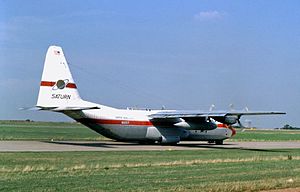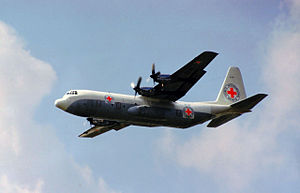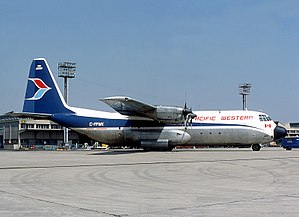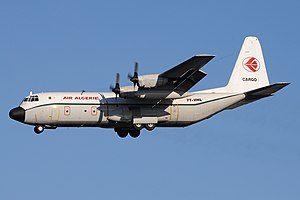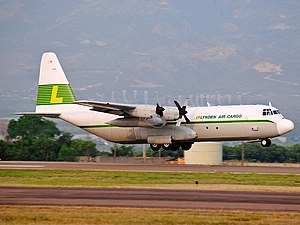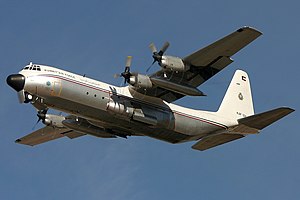Lockheed L-100 Hercules
| Lockheed L-100 Hercules | |
|---|---|
 L-100-30 Hercules D-ACWF Commercial Aviation , 1983 L-100-30 Hercules D-ACWF Commercial Aviation , 1983
|
|
| Type: | Transport plane |
| Design country: | |
| Manufacturer: | |
| First flight: |
April 20, 1964 |
| Commissioning: |
March 8, 1965 |
| Production time: |
1964–1992, from 2017 |
| Number of pieces: |
119 |
The Lockheed L-100 Hercules is a transport aircraft produced by the US American manufacturer Lockheed Corporation . Equipped with four turboprop engines, the shoulder- wing aircraft is the civil version of the military C-130 Hercules .
Since its first flight on August 23, 1954 as the military YC-130, the Hercules has been one of the aircraft with the longest-running series production; in 2020 it has been built without interruption for 66 years. To date, over 2500 Hercules have been made.
In 2015, more than 55 L-100 were still in use.
history
In 1959, Lockheed announced that US airline Pan American World Airways (Pan Am) had ordered 12 GL-207 Super Hercules for delivery in early 1962 and that Slick Airways would receive 6 copies later that year. However, both companies canceled their orders, and other civil versions did not get beyond the study phase.
At the beginning of the 1960s, a civil version was designed again, derived from the military Lockheed C-130E . The differences were the elimination of the external tanks and the two lower windows below the upper row of windows. In addition, neither the navigator nor military communication devices were needed any longer.
The first flight of this Lockheed L-100 Hercules took place on April 20, 1964. The type certificate for L-100 by the Federal Aviation Administration (FAA) took place on February 16 1965th
The first scheduled service was carried out on March 8, 1965 by Alaska Airlines , to which the prototype had been leased. The first machine from series production was delivered to Continental Air Services on September 30, 1965. This was a subsidiary of Continental Airlines , which worked very closely with Air America , which in turn was controlled by the CIA . Other early customers of this first variant included Airlift International , International Aerodyne, Pacific Western Airlines , Pakistan International Airlines and Zambian Air Cargoes as well as the leasing company National Aircraft Leasing.
In contrast to military use, high-density goods are rarely transported in the civil freight business, which is why the L-100 was more frequently restricted due to a lack of cargo space. That is why the L-100-20, stretched by 2.54 meters, was developed and made its maiden flight on April 19, 1968. The FAA type certification for the L-100-20 was on October 4, 1968.
The first production aircraft of the L-100-20 was delivered to Interior Airways on October 11, 1968, the next from December 26, 1969 to Flying W Airways. Other customers for the L-100-20 included Delta Airlines , again Pacific Western Airlines, Red Dodge Aviation, Saturn Airways and Southern Air Transport.
Even the already extended L-100-20 turned out to be too small for some operators. For this reason, a variant L-100-30 stretched by a further 2.04 meters was constructed, which is 4.58 meters longer than the basic version L-100. The first of these was delivered to Saturn Airways in December 1970.
In 1992 the sales of the L-100 continued to decline. One of the main reasons for this arose after the dissolution of the Soviet Union and the collapse of the previous governments of its allies. This led to the rapidly expanding use of freighters of the Antonov An-12 type internationally , which is comparable to the Hercules but has lower direct operating costs. There were hundreds of examples of this also very robust and versatile type of aircraft, for which new uses were sought and found. Therefore, the production of the L-100 was initially stopped in 1992 due to lack of demand.
It was not until 2014 that the manufacturing company - now called Lockheed Martin - decided to make a new attempt to revive civilian sales of the Hercules and notified the FAA of the intention to extend the type certification. The new version LM-100J is derived directly from the C-130J-30, which had its maiden flight on April 5, 1996 and has since been built in over 400 copies.
The LM-100J took off on its maiden flight on May 27, 2017; a second prototype was first used for testing in 2018.
The main differences to the military C-130J are
- a two-person cockpit
- modern Rolls-Royce AE2100D3 engines with six-blade propellers
- a door between cockpit and cargo hold (the C-130 only has one opening there)
- no toilet because, according to Lockheed Martin, civil flights are mostly "relatively short".
The LM-100J prototype was used to deliver relief supplies in Puerto Rico after Hurricane Maria in October 2017 .
construction
For construction, see article Lockheed C-130 . Deviations from the military version described there are mentioned in the local text.
Versions
The quantities of the following series apply to brand-new units:
- L-100 (L-382), 1 prototype built
- L-100 (L-382B), 21 built
- L-100-20 (L-382E), built: 27, plus 9 rebuilt from L-100; 9 L-100-20 were converted to L-100-30
- stretched 2.54 meters
- L-100-30 (L-382G), 69 built
- stretched by a further 2.04 meters, i.e. 4.58 meters longer than the basic version L-100
- LM-100J (L-382J), 2 prototypes were built by 2020
- same dimensions as L-100-30.
use
As with the military version C-130, it has proven to be a great advantage for most operators of the L-100 that it can take off and land on relatively short and unpaved runways. The L-100 are used in a variety of ways. This includes the transport of large and bulky goods, for example for the oil and gas drilling industry, disaster relief, spray operations (also to combat oil spills ), as a fire-fighting aircraft. In Saudi Arabia , 6 L-100-30s have been converted into flying hospital wards.
Civil operator
Numerous civil users operated both brand new and used L-100s. These included:
- Air Algérie
- Air America (Continental Air Services)
- Air Botswana
- Air China
- Air Contractors (Ireland)
- Airlift International (USA)
- Alaska Airlines
- Alaska International Air (until 1972 Interior Airways )
- Delta Airlines (USA)
- Ethiopian Airlines
- First Air (Canada)
- Flying W Airways (USA)
- HeavyLift Cargo Airlines (UK)
- Jet Fret (France)
- Libyan Arab Air Cargo
- Lynden Air Cargo (USA)
- Maximus Air Cargo (United Arab Emirates)
- Merpati Nusantara Airlines (Indonesia)
- Northwest Territorial Airways (Canada)
- Pacific Western Airlines (Canada)
- Pelita Air Service (Indonesia)
- Philippine Aerotransport
- Safair (South Africa)
- Satena (Colombia)
- Saudi Arabian Airlines
- SFAir (France)
- Southern Air (USA)
- Southern Air Transport (USA)
- St. Lucia Airways
- TAME (Ecuador)
- Tepper Aviation (USA)
- Trans-Africa (Angola)
- Saturn Airways
- Transamerica Airlines
- Trans International Airlines (USA)
- Trans Mediterranean Airways (Lebanon)
- Uganda Air Cargo
- Business flight (Germany)
- Zambia Air Cargoes
- Zimex Aviation (Switzerland)
Military operator
Air forces, semi-military or government organizations also began to use the L-100, sometimes in parallel with the existing C-130.
- Algerian Air Force
- Argentine Air Force
- Ecuadorian Air Force
- Gabonese Air Force
- Indonesian Air Force
- Kuwaiti Air Force
- Libyan Air Force
- Pakistan Air Force
- Peruvian Air Force
- Philippine Air Force
- Saudi Air Force
- SATCO (Peru)
- TAM - Transporte Aéreo Militar (Bolivia)
- United Arab Emirates Air Force
Sales figures and orders for the LM-100J
LM-100J: At the Air Show in Farnborough (England) on July 16, 2014, the Irish ASL Aviation Group signed a letter of intent to purchase up to 10 LM-100Js, which will be used by the two ASL-affiliated airlines Safair (South Africa) and Air Contractors (Ireland) are planned. Lockheed said it expects to sell 75 aircraft.
In 2018 there was no longer any talk of this customer, instead Lockheed presented the unknown company Pallas Aviation as its first customer. The company plans to operate two LM-100Js from the Fort Worth Alliance Airport.
Incidents
Technical specifications
| Parameter | L-100 data | L-100-20 data | Data of the L-100-30 |
|---|---|---|---|
| crew | 3–4 (2 pilots, flight engineer, loadmaster) | ||
| length | 29.79 m | 32.34 m | 34.37 m |
| span | 40.41 m | ||
| height | 11.66 m | ||
| Wing area | 162.12 m² | ||
| Wing extension | 10.09 | ||
| payload | 21,767 kg | 21,130 kg | 23,136 kg |
| Empty mass | 31,717 kg | 33,301 kg | 35,260 kg |
| Max. Takeoff mass | 70,308 kg | ||
| Cruising speed | 556 km / h (300 kts) | ||
| Top speed | 575 km / h (310 kts) | 570 km / h (308 kts) | 581 km / h (314 kts) |
| Service ceiling | 10,360 m (34,000 ft) | ||
| Range | 2,526 km (max.payload), 9,227 km (without payload) | ||
| Engines | 4 × Allison 501-D22 turboprop engines, each with 2,979 kW (4,050 PS) |
4 × Allison T56 -A-15 turboprop engines, each with 3,316 kW (4,509 PS) |
|
See also
literature
- Achim Figgen, Diethmar Plath, Brigitte Rothfischer: Transportflugzeuge , Bechtermünz Verlag, Augsburg 2000, ISBN 3-8289-5349-2 .
Web links
Individual evidence
- ↑ Peter C. Smith: The Lockheed Martin C-130 Hercules - A Complete History , Manchester 2010, ISBN 9 780859 791533, p. 60.
- ↑ Lars Olausson: Lockheed Hercules 1954-2005 , Såtenäs 2004, p. 139.
- ↑ Lockheed Martin Brochure C-130J Super Hercules, page 31, as of October 2018 (English), accessed on February 19, 2020.
- ↑ Lockheed Martin, Origin and Properties of the LM-100J, p. 2 (English), accessed on February 19, 2020.
- ↑ René J. Francillon: Lockheed Aircraft since 1913. Putnam Aeronautical Books, London 1987, ISBN 0-85177-805-4 , pp. 372-373.
- ^ John WR Taylor: Jane's All The World's Aircraft, 1971-72 . Jane's Yearbooks, London 1971, p. 338.
- ^ Smith 2010, p. 328.
- ↑ Francillon 1987, p. 373.
- ↑ Francillon 1987, p. 374.
- ↑ Lockheed Martin, Origin and Properties of the LM-100J, p. 2 (English), accessed on February 19, 2020.
- ↑ Lockheed Martin Brochure C-130J Super Hercules, page 5, as of October 2018 (English), accessed on February 19, 2020.
- ↑ aero.de, May 27, 2017 , accessed on February 19, 2020.
- ↑ Lockheed Martin brochure LM-100J Super Hercules, 2017 (English), accessed February 19, 2020.
- ↑ Lockheed Martin, The Origin and Properties of the LM-100J, p. 3 , accessed on February 19, 2020.
- ↑ Lockheed Martin, general brochure LM-100J Commercial Freighter (2017) (English), accessed February 19, 2020.
- ↑ Olausson 2005, p. 139.
- ↑ Lockheed Martin brochure LM-100J Fire Herc , accessed February 19, 2020.
- ↑ Olausson 2005, pp. 142-144.
- ↑ Francillon 1987, p. 375.
- ↑ Olausson 2005, pp. 145-146.
- ↑ Lockheed Martin, L-100 to LM-100J, p. 1 , accessed on February 19, 2020.
- ↑ Lockheed Martin, The Origin and Properties of the LM-100J, p. 4 , accessed on February 19, 2020.
- ↑ Flight International, October 12, 2018 , accessed on February 19, 2020.
- ^ John WR Taylor: Jane's All The World's Aircraft, 1971-72 . Jane's Yearbooks, London 1971, p. 338.
- ↑ John WR Taylor: Jane's All The World's Aircraft, 1977-78 . Jane's Yearbooks, London 1977, pp. 335-336.
- ↑ Smith 2010, pp. 60-67.


